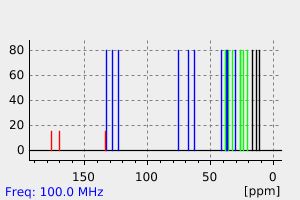ML-236B (compactin) | 125133-73-5
中文名称
——
中文别名
——
英文名称
ML-236B (compactin)
英文别名
Mevastatin;4-hydroxy-6-{2-[2-methyl-8-(2-methyl-butyryloxy)-1,2,6,7,8,8a-hexahydro-naphthalen-1-yl]-ethyl}-tetrahydro-pyran-2-one;compactin;8-[2-(4-Hydroxy-6-oxotetrahydro-2h-pyran-2-yl)ethyl]-7-methyl-1,2,3,7,8,8a-hexahydronaphthalen-1-yl 2-methylbutanoate;[8-[2-(4-hydroxy-6-oxooxan-2-yl)ethyl]-7-methyl-1,2,3,7,8,8a-hexahydronaphthalen-1-yl] 2-methylbutanoate
CAS
125133-73-5
化学式
C23H34O5
mdl
——
分子量
390.52
InChiKey
AJLFOPYRIVGYMJ-UHFFFAOYSA-N
BEILSTEIN
——
EINECS
——
-
物化性质
-
计算性质
-
ADMET
-
安全信息
-
SDS
-
制备方法与用途
-
上下游信息
-
文献信息
-
表征谱图
-
同类化合物
-
相关功能分类
-
相关结构分类
计算性质
-
辛醇/水分配系数(LogP):3.9
-
重原子数:28
-
可旋转键数:7
-
环数:3.0
-
sp3杂化的碳原子比例:0.74
-
拓扑面积:72.8
-
氢给体数:1
-
氢受体数:5
上下游信息
反应信息
-
作为反应物:参考文献:名称:TERAHARA, AKIRA;HAMANO, KIYOSHI;TSUJITA, YOSHIO;TANAKA, MINORU摘要:DOI:
文献信息
-
[EN] ANTIOXIDANT, NEUROPROTECTIVE AND ANTINEOPLASTIC NANOPARTICLES COMPRISING A THERAPEUTIC AGENT ON AN AMPHIPHILIC SPACER OR AN AMPHIPHILIC POLYMER<br/>[FR] NANOPARTICULES ANTIOXYDANTES, NEUROPROTECTRICES ET ANTINÉOPLASIQUES COMPRENANT UN AGENT THÉRAPEUTIQUE SUR UN ESPACEUR AMPHIPHILE OU UN POLYMÈRE AMPHIPHILE申请人:CEDARS SINAI MEDICAL CENTER公开号:WO2013016696A1公开(公告)日:2013-01-31This invention relates to antioxidant, neuroprotective and antineoplastic nanoparticles comprising a therapeutic agent on an amphiphilic spacer or an amphiphilic polymer. Methods of synthesizing the antioxidant derivatives of camptothecin and antioxidant derivatives of camptothecin analogs, NSAIDs and statins, spontaneous emulsification or nanoprecipitation thereof to produce antioxidant, neuroprotective and anti-neoplastic nanoparticles comprising a therapeutic agent on an amphiphilic spacer or an amphiphilic polymer and their use in treating cancerous diseases are also provided. A further aspect of this invention is the use of these neuroprotective and anti-neoplastic nanoparticles for the preparation of delivery devices of other pharmaceuticals and/or drugs.
-
Model Animal for Pregnancy-induced Hypertension Syndrome, and Treatment Method Therefor申请人:Okabe Masaru公开号:US20150264901A1公开(公告)日:2015-09-24A lentiviral vector was used to produce non-human animals that express human sFLT1 specifically in the murine placenta, to provide model animals of diseases such as pregnancy-induced hypertension syndrome that are close to the clinical conditions, methods for producing the model animals, methods of screening for candidate compounds as therapeutic agents for diseases such as pregnancy-induced hypertension syndrome by using the model animals, and therapeutic agents for diseases such as pregnancy-induced hypertension syndrome. As a result, the model animals were found to exhibit symptoms that are very close to the clinical conditions in human, which are presentation of hypertension as well as placental insufficiency, intrauterine growth retardation, glomerulosclerosis, and proteinuria during pregnancy, and improvement of those symptoms postpartum. Furthermore, when pravastatin was administered to this model animal, it was found that diseases such as pregnancy-induced hypertension syndrome were improved by the activation of placenta-derived growth factor (PIGF) which antagonizes sFLT1.
-
MODEL ANIMAL FOR PREGNANCY-INDUCED HYPERTENSION SYNDROME, AND TREATMENT METHOD THEREFOR申请人:Okabe, Masaru公开号:EP2543729A1公开(公告)日:2013-01-09A lentiviral vector was used to produce non-human animals that express human sFLT1 specifically in the murine placenta, to provide model animals of diseases such as pregnancy-induced hypertension syndrome that are close to the clinical conditions, methods for producing the model animals, methods of screening for candidate compounds as therapeutic agents for diseases such as pregnancy-induced hypertension syndrome by using the model animals, and therapeutic agents for diseases such as pregnancy-induced hypertension syndrome. As a result, the model animals were found to exhibit symptoms that are very close to the clinical conditions in human, which are presentation of hypertension as well as placental insufficiency, intrauterine growth retardation, glomerulosclerosis, and proteinuria during pregnancy, and improvement of those symptoms postpartum. Furthermore, when pravastatin was administered to this model animal, it was found that diseases such as pregnancy-induced hypertension syndrome were improved by the activation of placenta-derived growth factor (PIGF) which antagonizes sFLT1.
-
Murakawa, Shigeo; Nakamura, Takeshi; Komagata, Daisuke, Agricultural and Biological Chemistry, 1987, vol. 51, # 7, p. 1879 - 1884作者:Murakawa, Shigeo、Nakamura, Takeshi、Komagata, Daisuke、Sunagawa, Emi、Endo, AkiraDOI:——日期:——
-
ENDO, AKIRA;YAMASHITA, HARUYUKI作者:ENDO, AKIRA、YAMASHITA, HARUYUKIDOI:——日期:——
表征谱图
-
氢谱1HNMR
-
质谱MS
-
碳谱13CNMR
-
红外IR
-
拉曼Raman
-
峰位数据
-
峰位匹配
-
表征信息
同类化合物
(+)-(3R)-3-{[叔丁基(二甲基)硅基]氧基}二氢呋喃-2(3H)-酮
龙胆黄碱
龙胆酮胺
高良姜萜内酯
高柠檬酸-gamma-内酯
高普伐他汀内酯二-(叔-丁基二甲基硅烷基)醚
马桑内酯
顺式蒈醛酸内酯
顺式-3,5-二甲基二氢-2H-吡喃-2,6(3H)-二酮
顺式-1,3-环戊烷二甲酸酐
顺式-1,3-环己烷二甲酸酐
阿拉伯酸,2-氨基-2,3,5-三脱氧-3-甲基-,γ-内酯(9CI)
酸,(1S,3R,4R,5R)-3,4-二羟基-7-羰基-6-氧杂二环[3.2.1]辛-1-基2,2,2-三氯乙基酯碳
辛伐他汀4'-甲基醚
辛伐他汀
软木三萜酮3,4-内酯
试剂Menthide
试剂6-Allyl-epsilon-caprolactone
表洛伐他汀
蜂毒
藻酸钠
薇甘菊内酯
葡醛内酯
葡庚糖酸内酯
葡庚糖酸內酯
莫那可林X
莫那可林L
莫那可林J
脱氢抗坏血酸
聚乌拉坦
聚(epsilon-己内酯-delta-戊内酯)
羟基马桑毒内酯
羟基蓍含蓍素
羟基己酸内酯与2,2-二甲基-1,3-丙二醇的聚合物
美伐他汀
绵毛马兜铃内酯
糖质酸-1,4-内酯
穿心莲内酯
科立内脂二醇
硫丹内酯
石蚕苷A
甲酰辛伐他汀
甲瓦龙酸内酯-D4
甲瓦龙酸内酯-D3
甲瓦龙酸内酯-1-13C
甲瓦龙酸内酯-1,2-13C2
甲瓦龙酸内酯
甲基丙烯酸甲瓦龙酸内酯
甲基[(1S,5R,6R)-3-氧代-2-氧杂双环[3.2.1]辛-6-基]乙酸酯
瑞舒伐他汀杂质113







